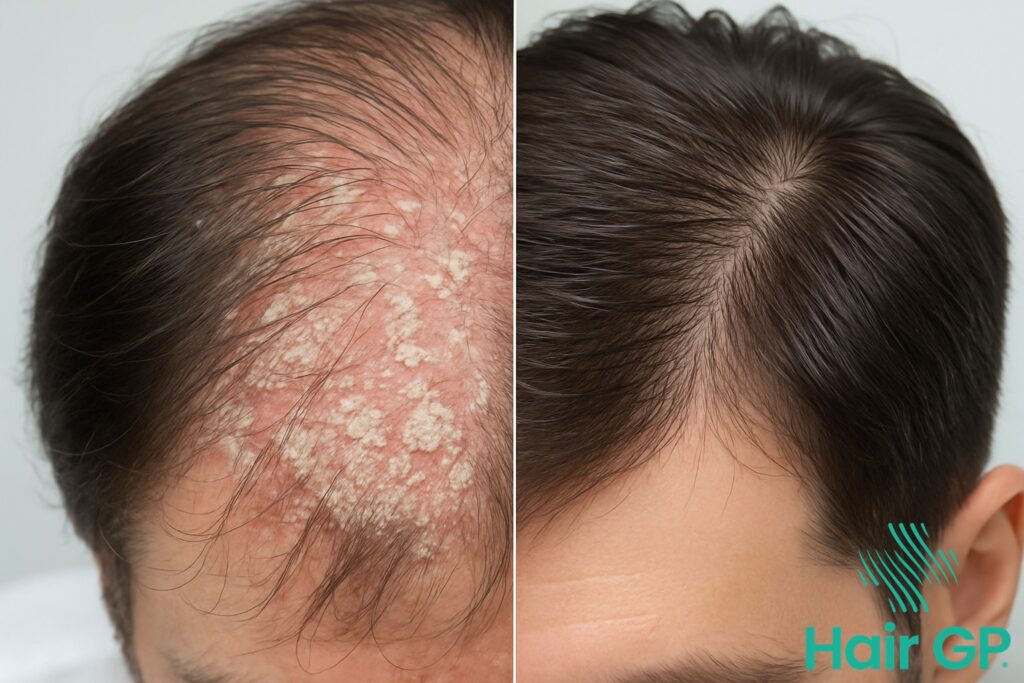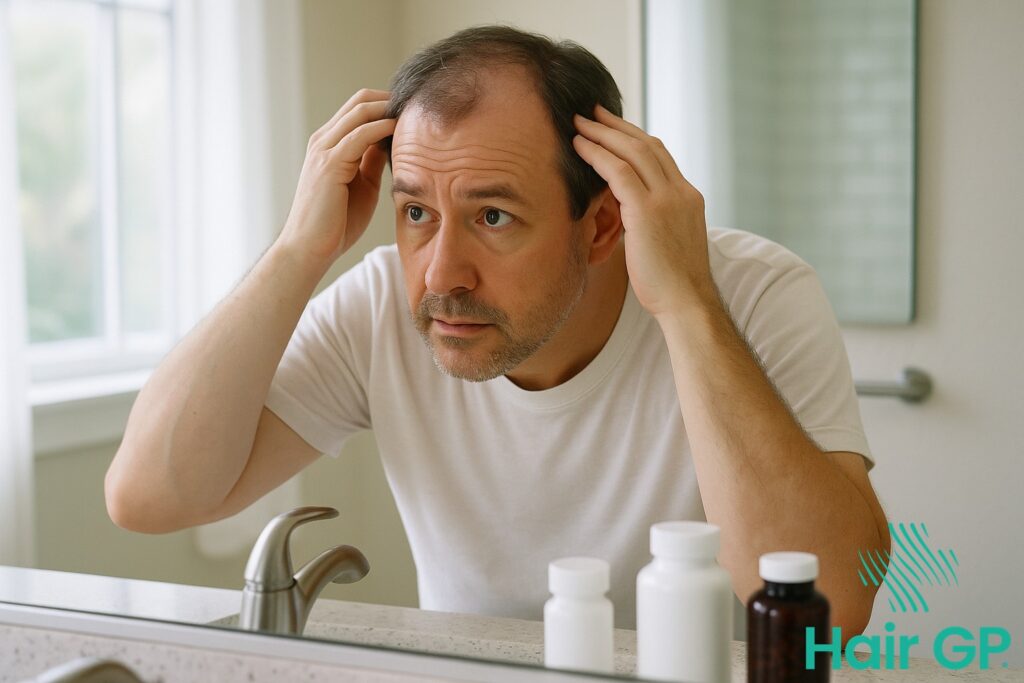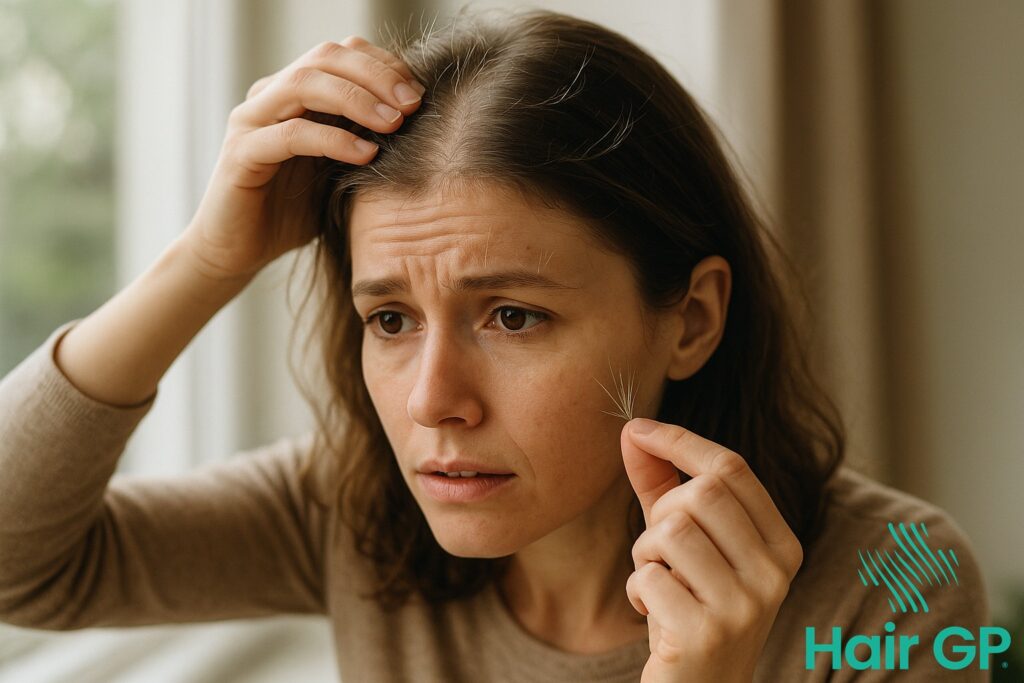Introduction
Hair loss can be a distressing experience, particularly when its underlying cause remains unclear. Whilst many factors contribute to thinning hair, one often overlooked culprit is candida overgrowth on the scalp. The Candida-Hair Loss Link: Yeast Overgrowth and Scalp Health represents a complex relationship that affects thousands of people worldwide, yet remains poorly understood by many sufferers.
Candida, a naturally occurring yeast in our bodies, can transform from harmless resident to harmful invader when conditions favour excessive growth. When this yeast overgrowth occurs on the scalp, it creates various scalp conditions that directly impact hair follicles, potentially leading to noticeable hair loss and compromised scalp health.
This comprehensive guide explores how candida affects your scalp’s delicate ecosystem, examining the scientific mechanisms behind yeast-related hair damage. You’ll learn to recognise early warning signs, understand risk factors that predispose you to infection, and discover both medical and natural treatment approaches. We’ll also provide essential prevention strategies and guidance on when professional intervention becomes necessary, empowering you to take control of your scalp health and hair restoration journey.
Key Takeaways – TL/DR
- Candida albicans overgrowth can damage hair follicles and lead to temporary or permanent hair loss
- Common symptoms include itchy scalp, dandruff, redness, and patchy hair loss in affected areas
- Treatment combines antifungal medications, medicated shampoos, and lifestyle changes to restore scalp health
- Early intervention prevents permanent damage to hair follicles and promotes healthy hair regrowth
Understanding Candida and Its Impact on Scalp Health
Candida albicans represents a common inhabitant of the human microbiome that can transform from beneficial yeast to problematic pathogen under certain conditions. Understanding how this organism functions on scalp tissue and the mechanisms triggering overgrowth provides crucial insight into preventing and treating scalp-related candidiasis effectively.
What is Candida Albicans?
Candida albicans exists as part of the normal flora in approximately 60-70% of healthy individuals[1]. This opportunistic fungal organism typically resides harmlessly on skin surfaces, mucous membranes, and the gastrointestinal tract. Under balanced conditions, beneficial bacteria and the immune system maintain candida populations at manageable levels.
However, when environmental conditions shift favourably, this benign yeast transforms into an opportunistic pathogen capable of causing fungal infections. Factors including antibiotic use, hormonal changes, and compromised immunity can disrupt the delicate microbial balance, allowing excessive yeast overgrowth.
How Yeast Overgrowth Occurs on the Scalp
The scalp provides an ideal environment for candida proliferation when specific conditions arise. Excessive moisture from sweat, inadequate drying after washing, or humid climates creates perfect breeding grounds for scalp fungus. Additionally, pH imbalance plays a crucial role – whilst healthy scalp pH ranges between 4.5-5.5, alkaline conditions above 6.0 significantly promote fungal growth[2].
Compromised immunity further exacerbates susceptibility to scalp candidiasis. Stress, nutritional deficiencies, and underlying health conditions weaken the body’s natural defences, enabling unchecked yeast multiplication across scalp tissue.
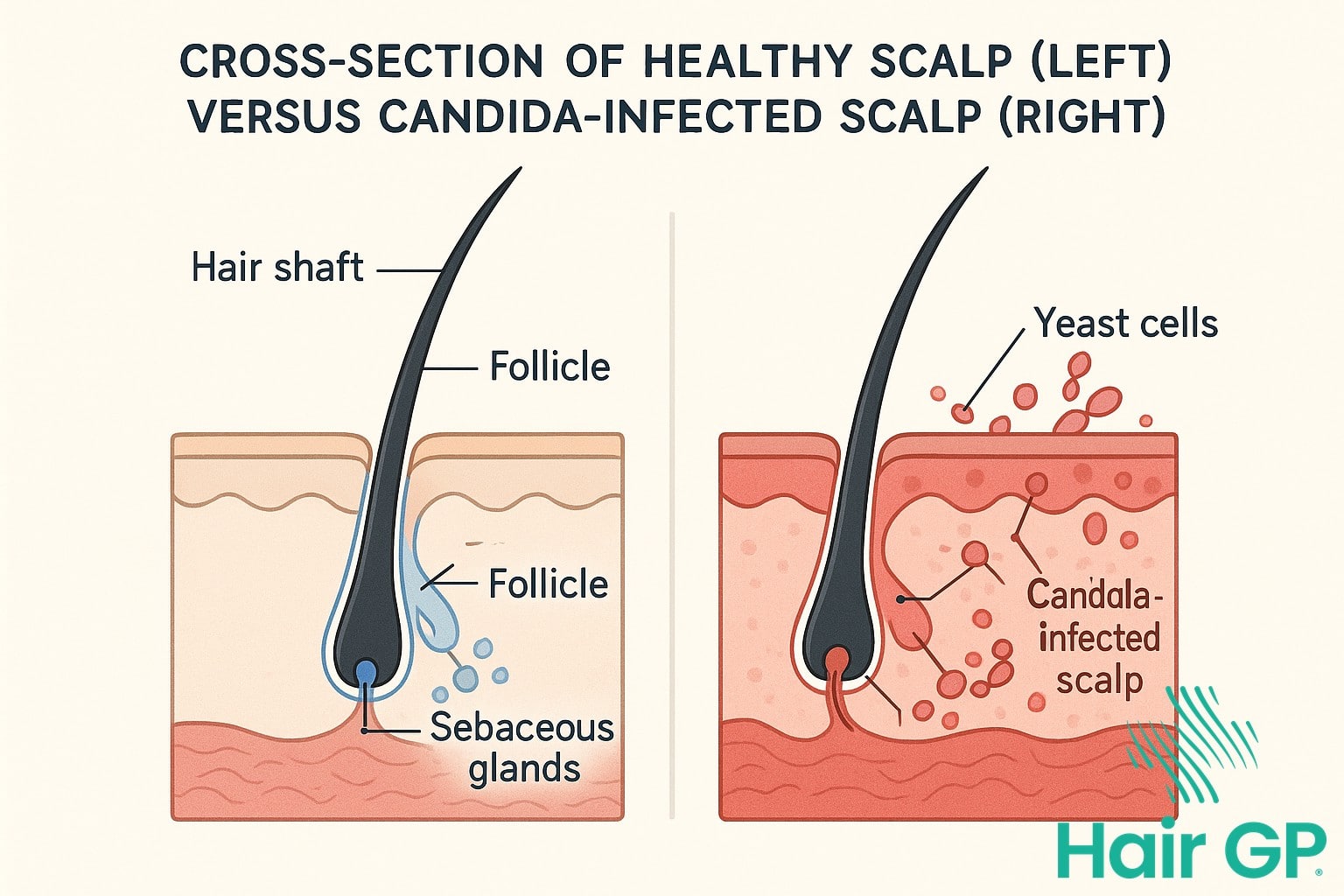
The Science Behind Candida-Related Hair Loss
When Candida overgrowth occurs on the scalp, it triggers a cascade of biological processes that can severely damage hair follicles and disrupt normal hair growth cycles. This fungal colonisation initiates inflammatory responses and structural changes that may result in both temporary and permanent hair loss, depending on the severity and duration of the infection.
How Candida Damages Hair Follicles
Candida overgrowth initiates follicular damage through multiple mechanisms. The primary pathway involves intense inflammation, as fungal colonisation triggers the release of pro-inflammatory cytokines that infiltrate the follicular unit [3]. This inflammatory cascade leads to perifollicular fibrosis and miniaturisation of hair follicles. Additionally, Candida depletes essential nutrients from the scalp environment, particularly zinc and biotin, which are crucial for healthy hair growth. The yeast’s metabolic byproducts create an acidic environment that further compromises follicular integrity. Structural damage occurs when fungal hyphae physically invade the hair shaft and follicular epithelium, disrupting the normal architecture and causing brittle, weakened hair that breaks easily.
Temporary vs. Permanent Hair Loss
The distinction between reversible and irreversible damage depends largely on early intervention and the extent of follicular destruction. Temporary hair loss typically occurs when the scalp infection caused by Candida is addressed promptly, allowing follicles to recover within three to six months [4]. However, chronic untreated infections can lead to scarring alopecia, where inflammatory damage destroys the follicular stem cells, resulting in permanent hair loss and potential baldness. The recovery timeline varies significantly, with mild cases showing improvement within weeks of antifungal treatment, whilst severe cases with follicular scarring may never fully recover their original hair density.
Recognizing Symptoms of Scalp Yeast Infections
Recognising the symptoms of scalp yeast infection early can make the difference between a minor inconvenience and significant hair loss. Understanding both subtle initial signs and advanced manifestations helps you identify when Candida overgrowth requires intervention, enabling prompt treatment before permanent damage occurs.
Early Warning Signs
The initial stages of scalp yeast infection often present subtle symptoms easily mistaken for common scalp conditions. Mild itching that intensifies after washing or sweating typically appears first, accompanied by an increasingly oily scalp despite regular cleansing. A slight, musty odour may develop, particularly noticeable when hair is damp. These early indicators differ from typical dandruff as they persist despite anti-dandruff treatments and gradually worsen without proper intervention.
Advanced Symptoms
When left untreated, scalp yeast infections progress to more severe manifestations requiring immediate medical attention. Visible patches of inflamed, reddened skin emerge, often accompanied by yellowish scales distinct from regular dandruff. Severe inflammation leads to intense scalp irritation and burning sensations. Hair loss patterns become evident, with increased shedding progressing to noticeable bald spots. Unlike tinea capitis, which causes circular patches, yeast-related hair loss typically appears as diffuse thinning across affected areas.
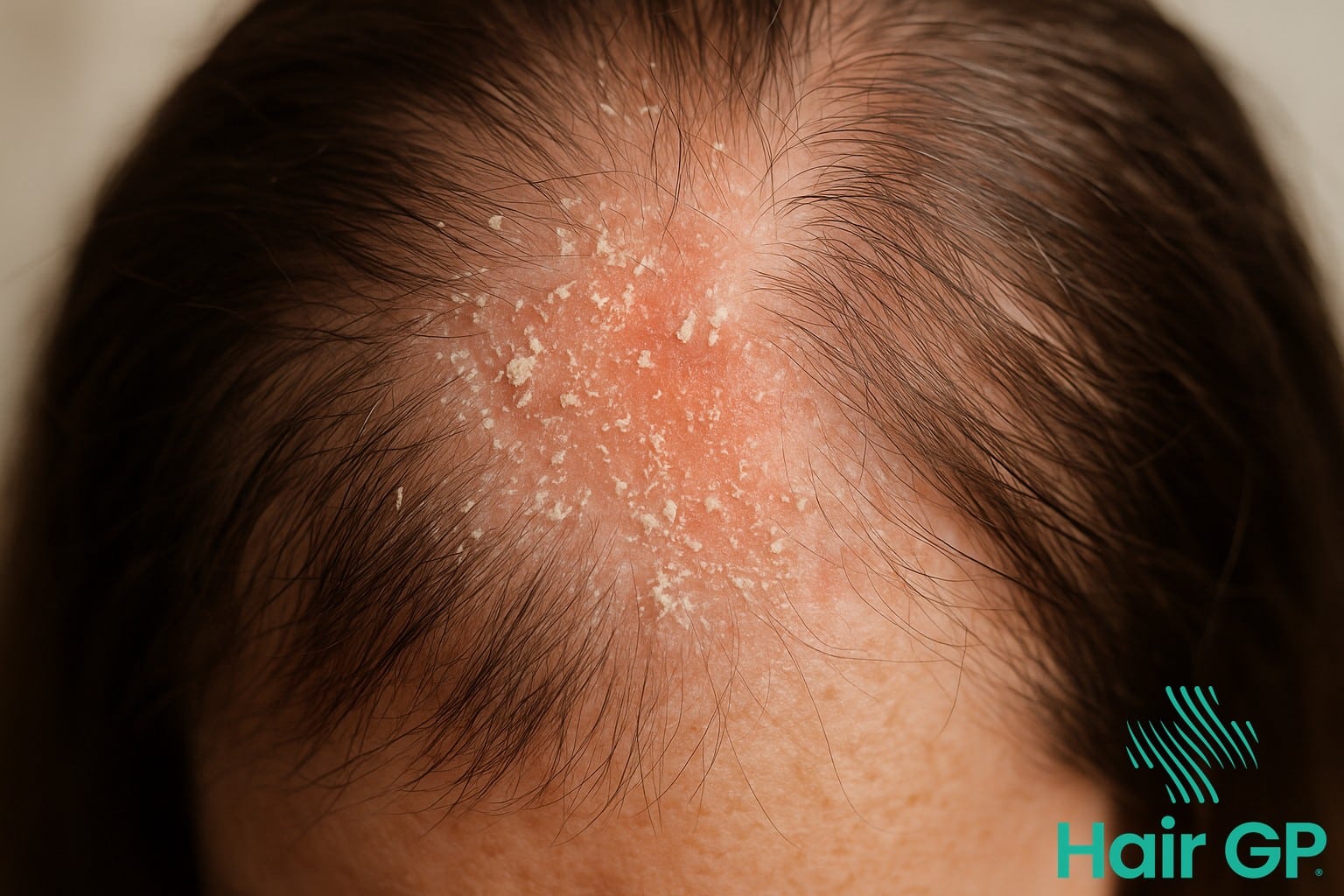
Risk Factors and Underlying Causes
Several interconnected factors increase susceptibility to scalp candidiasis and associated hair loss. Poor scalp hygiene creates an environment where yeast thrives, as accumulated dead skin cells and sebum provide nutrients for fungal proliferation. Research indicates that approximately 10-15% of individuals with recurrent scalp infections have inadequate hygiene practices contributing to their condition[5].
Compromised immunity represents another significant risk factor. Conditions such as HIV/AIDS, diabetes, and cancer treatments suppress immune function, allowing opportunistic organisms to flourish. Hormonal imbalances, particularly hypothyroidism, alter sebum production and skin pH levels, creating conditions where yeast grows unchecked. Studies show that thyroid dysfunction affects up to 8% of women experiencing chronic scalp conditions[6].
Seborrheic dermatitis frequently coexists with candida overgrowth, as both conditions involve similar inflammatory pathways and altered skin barrier function. Lifestyle factors further compound risk, including excessive stress, poor nutrition, and overuse of harsh hair products that disrupt the scalp’s natural microbiome. Additionally, prolonged antibiotic use eliminates beneficial bacteria that normally compete with yeast, whilst high-sugar diets feed fungal growth. Understanding these multifaceted risk factors enables targeted prevention strategies and more effective treatment approaches for those susceptible to scalp candidiasis.
Medical Treatment Options for Scalp Candida
Effective medical treatment for scalp candidiasis requires targeted antifungal therapy, ranging from topical solutions to systemic medications depending on infection severity. Healthcare professionals typically prescribe a combination of prescription medications and specialised treatments to eliminate fungal overgrowth whilst addressing associated symptoms.
Prescription Antifungal Medications
Oral antifungal drugs provide comprehensive treatment for severe or persistent scalp candida infections. Fluconazole remains the first-line systemic therapy, typically prescribed at 100-200mg daily for 2-4 weeks, with some cases requiring extended treatment courses up to 6 weeks. Common side effects include nausea, headaches, and liver enzyme elevation, necessitating monitoring during treatment. Alternative systemic options include itraconazole and terbinafine, whilst topical nystatin cream may be prescribed for localised infections, applied twice daily directly to affected scalp areas.
Medicated Shampoos and Topical Treatments
Ketoconazole shampoo serves as the cornerstone of topical antifungal therapy, containing 2% active ingredient for prescription formulations. Application involves massaging into the scalp three times weekly, leaving for 5-10 minutes before rinsing thoroughly. Additional medicated shampoos include ciclopirox olamine and selenium sulphide, each targeting fungal cell membranes through different mechanisms. Treatment effectiveness typically becomes apparent within 2-4 weeks, with maintenance therapy often recommended to prevent recurrence. Combination approaches utilising both oral medications and topical treatments demonstrate superior outcomes, particularly in cases of extensive scalp involvement or treatment-resistant infections.
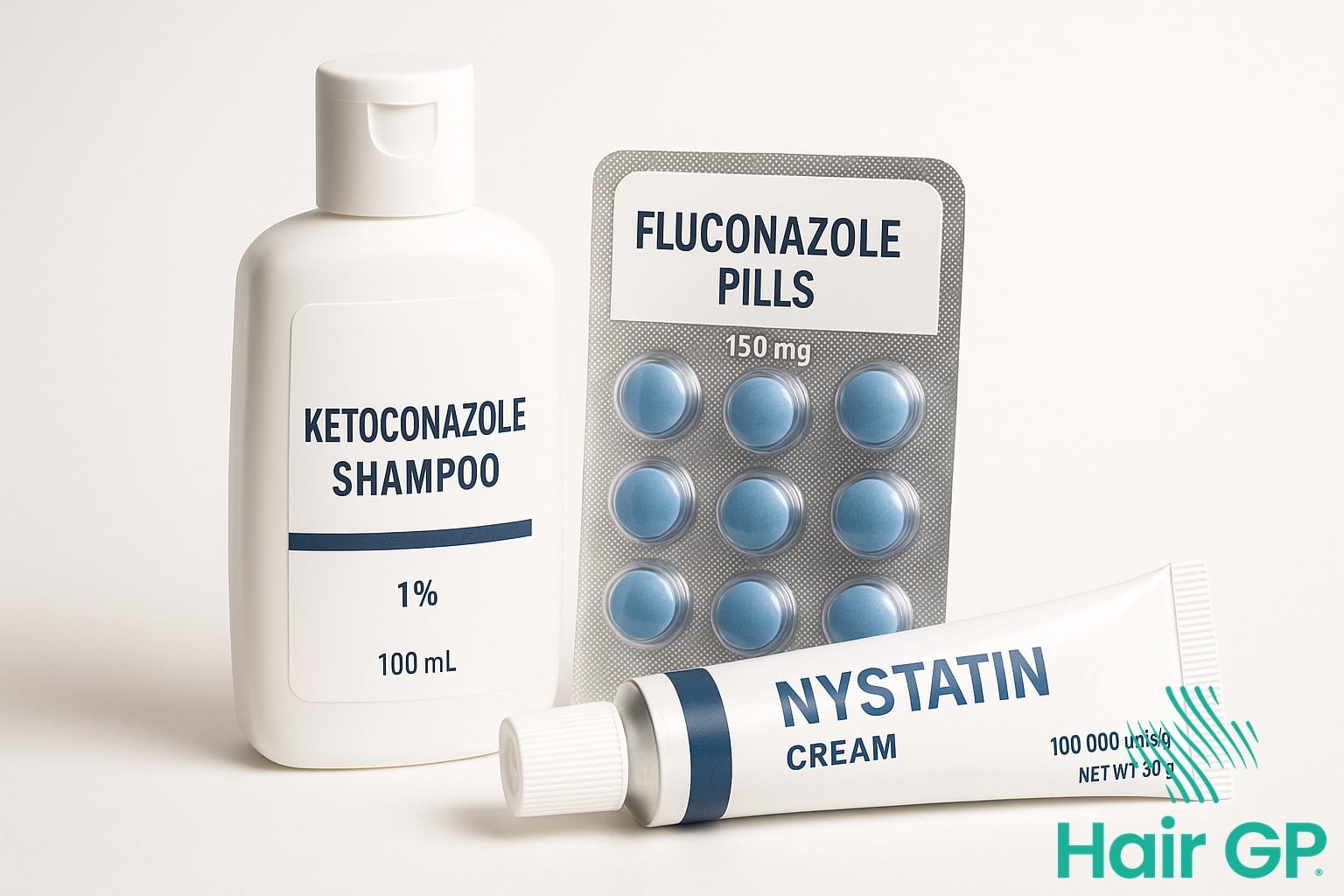
Natural and Home Remedies for Scalp Yeast
Natural remedies offer evidence-based alternatives that complement conventional treatments for scalp yeast infections. Whilst these home remedies shouldn’t replace medical care, research demonstrates their antifungal properties can effectively support recovery when used properly alongside prescribed treatments.
Apple Cider Vinegar Treatment
Apple cider vinegar’s acidic nature creates an inhospitable environment for yeast growth, helping restore your scalp’s natural pH balance. Mix one part apple cider vinegar with three parts water for safe application [7]. Apply this solution after shampooing, massage gently into the scalp, leave for five minutes, then rinse thoroughly. Use this treatment twice weekly initially, reducing to once weekly as symptoms improve. The vinegar helps keep your scalp clean whilst removing fungal debris.
Essential Oils and Natural Antifungals
Tea tree oil demonstrates potent antifungal properties, with studies showing effectiveness against various Candida species [8]. Always dilute essential oils properly—add 5-10 drops to a tablespoon of carrier oil like coconut oil, which itself possesses antifungal properties. Perform a patch test before full application to avoid irritation. Other effective options include oregano oil and lavender oil, which can be combined for enhanced results. These natural alternatives work well alongside over the counter treatments, but discontinue use if irritation occurs.
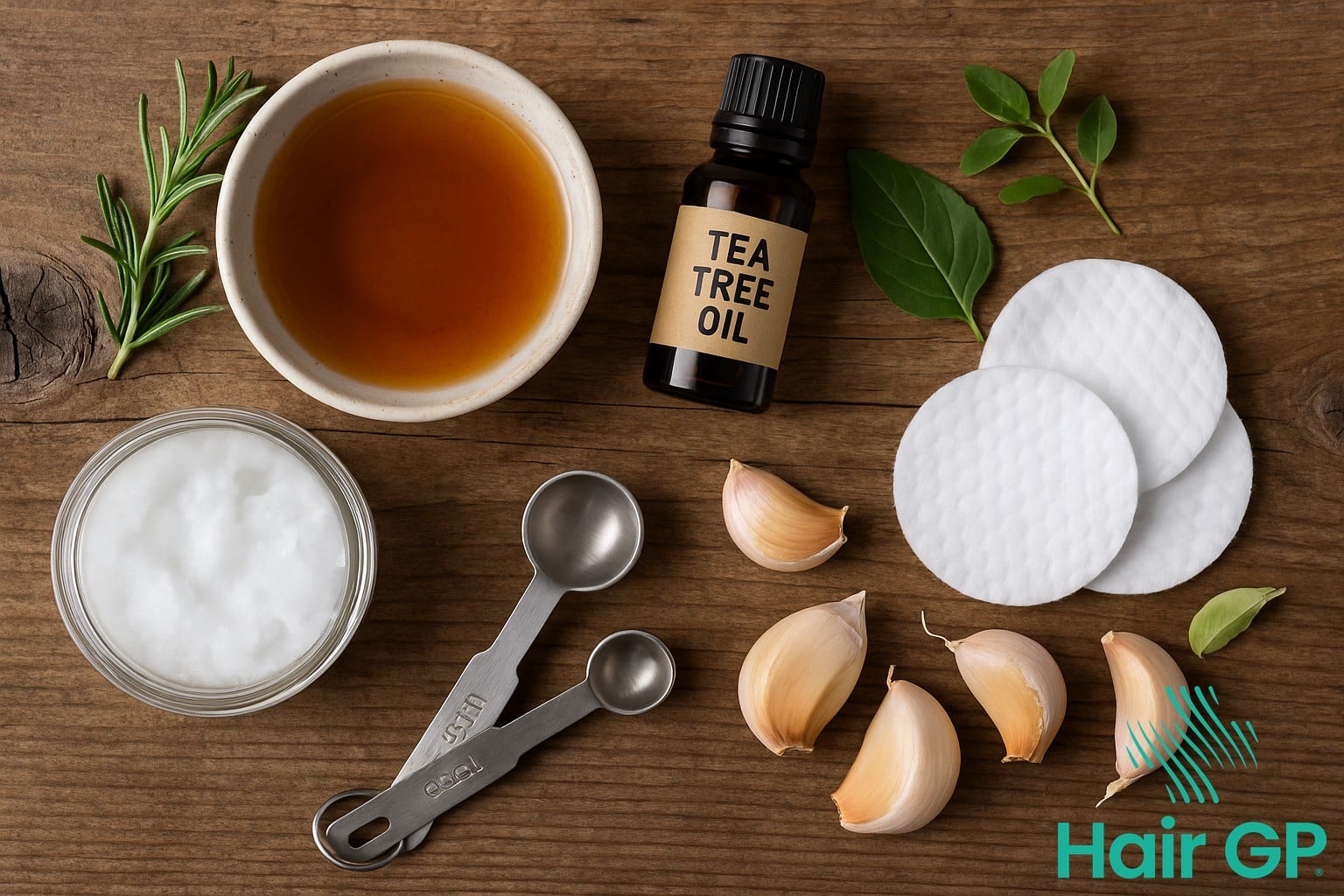
Prevention Strategies for Scalp Health
Maintaining a scalp clean and healthy is fundamental to preventing yeast infections and hair loss. Regular washing with gentle, pH-balanced shampoos removes excess oils and dead skin cells that promote fungal growth. Choose products specifically formulated for sensitive scalp conditions, avoiding harsh sulphates that strip natural protective oils. Wash hair every 2-3 days, adjusting frequency based on individual oil production and lifestyle factors.
Dietary modifications play a crucial role in prevention. Reducing sugar and refined carbohydrate intake starves yeast of their primary food source, whilst increasing probiotic-rich foods like yoghurt and fermented vegetables supports beneficial bacteria. Adequate hydration and omega-3 fatty acids from fish or supplements strengthen scalp barrier function.
Lifestyle adjustments significantly impact scalp health. Managing stress through regular exercise, meditation, or adequate sleep prevents hormonal imbalances that trigger yeast overgrowth. Avoid sharing personal items like combs, hats, or towels that can spread infections. After swimming or sweating, promptly wash and thoroughly dry hair to prevent moisture accumulation. These combined strategies create an inhospitable environment for pathogenic organisms whilst promoting optimal scalp wellness.
When to Seek Professional Help
Whilst mild scalp infections often respond to home remedies, certain warning signs indicate professional medical attention is essential. Seek immediate dermatological consultation if you notice spreading redness beyond the hairline, severe pain, fever, or swollen lymph nodes accompanying your scalp infection. These symptoms suggest a more serious condition requiring prescription treatment.
Additionally, if symptoms persist despite consistent home treatment for more than two weeks, or if the infection appears to worsen, professional diagnosis becomes crucial. What initially seems like candidiasis might actually be ringworm, eczema, or psoriasis, each requiring different therapeutic approaches. Recurring infections, particularly thrush that returns frequently, warrant thorough medical evaluation to identify underlying immune system issues. Don’t delay seeking help if you experience hair loss, open sores, or discharge from affected areas, as these complications can lead to permanent damage without proper intervention.
Conclusion
Understanding the connection between yeast causing hair loss and candida infections is crucial for maintaining optimal scalp health. Early recognition of symptoms enables prompt intervention, significantly improving treatment outcomes and preventing permanent follicle damage. The encouraging news is that candida-related hair loss is typically reversible with appropriate care.
Successful recovery requires a comprehensive approach combining medical treatments, such as antifungal shampoos and prescribed medications, with lifestyle modifications that address underlying causes. Most individuals who commit to proper treatment protocols experience substantial improvements in both scalp condition and hair growth within several months.
If you’re experiencing persistent itching, flaking, or unexplained hair thinning, don’t delay seeking professional evaluation. The sooner you address potential candida infections, the better your chances of full recovery. Remember that restoring scalp health is a gradual process requiring patience and consistency. With the right treatment plan and dedication to recommended changes, you can overcome candida-related hair loss and achieve healthy, thriving hair once again.
Frequently Asked Questions
Yes, if left untreated for extended periods, Candida can cause permanent damage to hair follicles leading to irreversible hair loss. However, early treatment typically results in full hair regrowth within 3-6 months.
Most people see improvement within 2-4 weeks of consistent use of ketoconazole or other antifungal shampoos. Complete resolution typically takes 6-8 weeks of regular treatment.
While Candida itself isn’t highly contagious between people, sharing personal items like combs, hats, or pillows can potentially spread the infection, especially in individuals with compromised immune systems.
Yes, high-sugar diets can feed yeast growth. Reducing sugar intake, increasing probiotics, and maintaining balanced nutrition can help prevent and manage scalp Candida overgrowth.
References
- Höfs S, Mogavero S, Hube B. Interaction of Candida albicans with host cells: virulence factors, host defense, escape strategies, and the microbiota. J Microbiol. 2016;54(3):149-169.
- Saxena R, Mittal P, Clavaud C, et al. Comparison of Healthy and Dandruff Scalp Microbiome Reveals the Role of Commensals in Scalp Health. Front Cell Infect Microbiol. 2018;8:346.
- Rudramurthy SM, Honnavar P, Chakrabarti A, et al. Association of Malassezia species with dandruff. Indian J Med Res. 2018;147(3):235-238.
- Pinto D, Sorbellini E, Marzani B, et al. Scalp bacterial shift in Alopecia areata. PLoS One. 2019;14(4):e0215206.
- Gupta AK, Mays RR, Dotzert MS, et al. Fungal infections of the scalp: Current treatment options. Expert Opin Pharmacother. 2018;19(2):165-181.
- Contreras-Ruiz J, Peternel S, Jiménez Gutiérrez C, et al. Double-blind, randomized, placebo-controlled study of a lotion containing triamcinolone acetonide 0.1% for the treatment of moderate-to-severe seborrheic dermatitis of the scalp. J Dermatolog Treat. 2019;30(6):542-547.
- Nazzaro F, Fratianni F, Coppola R, De Feo V. Essential Oils and Antifungal Activity. Pharmaceuticals (Basel). 2017;10(4):86.
- Carson CF, Hammer KA, Riley TV. Melaleuca alternifolia (Tea Tree) oil: a review of antimicrobial and other medicinal properties. Clin Microbiol Rev. 2006;19(1):50-62.

